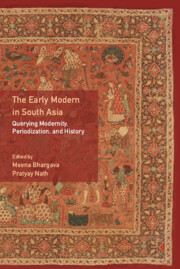5 - Early Modernity and South Asian Economic History: Problematic, Periodization, Processes, and Possibilities
Published online by Cambridge University Press: 06 September 2022
Summary
For South Asian history, the period between the mid-sixteenth century and the 1830s conventionally gets clubbed into the ambiguous and historiographically challenged rubric of ‘medieval’ history. This owes mainly to the enduring obsession of most historians writing from within the subcontinent with treating the term ‘medieval’ as equivalent to an Indo-Persian political system that stretched from the thirteenth century to the eighteenth. The thought of breaking it up into discrete components and tagging these to a different schema of periodization generates an anxiety which almost borders on hysteria. Since Meena Bhargava and Pratyay Nath, the editors of this volume, have extensively critiqued the notion of the medieval, this chapter will not get into the issue, except to say that the standard literature on this is overwhelmingly fiscal, with static parameters. This has resulted in an idiosyncratic analytical trap. While severe social inequalities and sharp conflicts in society are recognized, they are posited within a surprising degree of changelessness in the larger context. The critical variable influencing change or otherwise is assigned to cycles of state formation – one in the thirteenth and fourteenth centuries, and the second in the sixteenth and seventeenth centuries. Both the cycles are determined by the ability or inability of the state to refine its tax-assignment systems. While this fiscal drive tended to maximize appropriation and hence fall regressively on the poorest in the countryside, it did so while subverting ‘superior cultivation’ as well as simultaneously increasing the distance between the rural rich and poor. Stasis is implicit in this model because it ascribes one single cause to explain the same sort of change over six centuries. This remains by far the most structurally coherent overview of what I call the seamlessness of the medieval in Indian history. The more things changed, the more they remained the same in this framework, because the nature of the state is assumed to have remained the same through more than half a millennium. However, historians of this disposition use terms like ‘Mughal India’, ‘late medieval India’, or ‘late pre-colonial India’ as a nod to some unexplained difference after the sixteenth century; nevertheless, they land up projecting South Asia as unique, exotic, and somehow detached from global history.
- Type
- Chapter
- Information
- The Early Modern in South AsiaQuerying Modernity, Periodization, and History, pp. 103 - 123Publisher: Cambridge University PressPrint publication year: 2023



